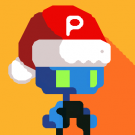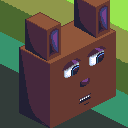Search the Community
Showing results for tags 'Cordova'.
-
Hello, I'm looking for feedback on my first game/mobile app: Amazeballs! https://play.google.com/store/apps/details?id=nl.eyeseet.maze It is a maze-escape game written in using Matter-js and Three.js and runs as an android app using Cordova. There are currently two modes, a top view mode and a 3D ground mode. As you finish levels you earn coins to buy upgrades (speed, manoeuverability and camera zoom out) which should help you finish larger mazes. I'd love to hear what you think of the game. Any feedback or ideas to improve the game are very welcome! Since I've seen the game grow it is hard for me to look at it with fresh eyes. It is hard to judge whether the game is still fun to play after a few levels, if the money/upgrade system balanced, etc. Also, I'd like to add new game modes, I have some ideas but more ideas are more than welcome. In the current version you start with 5000 coins so you can unlock both game modes right away.
-
Hi, I created a mobile game called “Circle Status” and developed it with my wife. The game takes place in a 2-dimensional world inhabited by polygons, inspired by Edwin Abbott’s Flatland universe. This is a world where polygons with fewer sides are seen as lower class citizens and those with many sides are considered the elite. You start off as a ‘lowly’ triangle and the goal is rise up the social ranks all the way to a circle. You do so by eating your peers and can use a variety of power-ups to help you along the way. We wrote up a blog on our process if anyone’s interested. The game can be downloaded here: Android Apple Please let me know what you think!
-
Hi i just finish a mini game with the idea come from compass. 360 Degree Spinning Shooter Space Game A Game that you need to move your whole body to play. New Type of Casual Mini Game. A shooter game with spinning 360 degree. *** WARNING *** - Not for pregnant woman and lazy people. - You could get throw up after some game. HOW TO PLAY Hold your phone flat in the palm of your hand Spin around while holding your phone in your hand to change direction of space ship Tap screen to fire the object TAP and HOLD to rapid fire when too many object appear. FEATURES. Number of object to show up will increase randomly. Fire rate decrease along with number object show up. Bullet, Object speed increase after every time destroy object. Spin your body all around. Some difference type of object. Some difference background. Best Score Shop to buy new ship Collect Star If you got any suggest. Please contact me. [email protected] Download iOS : https://apps.apple.com/us/app/360-shot-space/id1476517779?ls=1 Download Android : https://play.google.com/store/apps/details?id=shoting.threesixzero.com Demo Game Play without interact with the body move https://www.youtube.com/watch?v=7Ale_dozAv4 https://www.youtube.com/watch?v=v59WOi7MVn8 ScreenShot. I could not attack files for some reason.
-
With exactly the same codebase I have perfectly working Facebook events on Android. However, on iOS it doesn't works. I'm using https://github.com/jeduan/cordova-plugin-facebook4 for this and tried to set some alerts to see the error code or something (note `alert` in the code, for debugging purposes), but there is no action. In essence, I can't see any error, it just doesn't works. The following code: this.options = { method: 'apprequests', message: 'Play YellowSidd with me!' }; this.onSuccess = function(result) { alert("Success with invite, result: " + result); }; this.onError = function(msg) { alert("Failed with invite, msg: " + msg); }; facebookConnectPlugin.showDialog(this.options, this.onSuccess, this.onError); In the Xcode in Build Phases -> Compile Sources I do have FacebookConnectPlugin.m. In Build Phases -> Link Binary with Libraries I do have also the following: libsqlite3.dylib (added by me), Security.framework (added by me), Accounts.framework (added by me), Social.framework (added by me). Also, the FBSDKCoreKit.framework, FBSDKLoginKit.framework and FBSDKShareKit.framework. These last 3 were already in that project.
-
Has anyone ever seen this where my RAF wants to take up the entire frame (~15ms) but the processes within don't take very long (~3ms)? My app is running iOS on Cordova with wkwebview. Long RAFs: https://imgur.com/a/2KVeKJZ Processes within one RAF: https://imgur.com/a/CnUNSfk BUT When I zoom into the canvas (by doing the two finger swipe on the iPad) and then zoom out, the RAF fixes to take up only ~5ms total. After zoom trick: https://imgur.com/a/RSzmrTI Is the PIXI canvas loosing focus, like as if I went to another tab on the web? I'm not sure what is happening here, thanks for any help! ?
-
Hello, I'm having issues running PIXI with an autoDetectRenderer in Cordova iOS. It is very slow compared to just loading the page from Safari within iOS. The goal is 60fps but Cordova is getting ~25fps while Safari has performance that is good enough to be acceptable. Is there some kind of optimization I have to turn on? The cordova docs claim that the hardware acceleration config option is only available on OSX, not iOS. I ensured that my game loop function usually takes about 1-5 milliseconds to run in Cordova. Could it be some kind of overhead that Cordova has set up with plugins or something? The only cordova plugin I'm using is one that I created myself, which takes event input from an external musical bluetooth MIDI controller. My app is essentially a rhythm game with a big highway of arrows moving as one container with animated sprites that flash at different times and hide/show accordingly to how you played. How do I get comparable performance to iOS Safari on iOS Cordova with PIXI? (Btw using React to bundle and build all this). Thanks! ? Cordova docs: https://cordova.apache.org/docs/en/latest/config_ref/
-
Eternity Pilot is a mobile game made using Phaser 3 and Cordova. It is my first published game and it would have been totally impossible without Phaser and this amazing community! For now it is only available on Android but I am hoping to have an iOS version in the near future. I have a sign up on the site linked below to receive a notification when the iOS version comes out. Play Store https://eternitypilot.com Gameplay Video
- 3 replies
-
- phaser
- javascript
- (and 4 more)
-
When I started to create my game I wanted to make it look good on my own phone as a start. So I searched for my screen resolution and it is 1920*1080, so I decided to make my game 540 width and 960 height, making it the half from my res to not make the sprites too big and then scale it*2 in phaser. Yesterday I first tried it on my phone using cordova, and I can only see like 30% of my game because it is too big for the screen. And I dont really understand why is that happening.
-
Hi everyone, I'm just finish a simple game: QUE. Que's a lightweight game. Just tap and follow poses in your screen. Coding: HTML5/PIXIJS. Game: QUE - A simple tap style game with stick-man. Just tap and follow poses in your screen. Que's mean is stick-man in Vietnamese Screenshot: Fig1. Main menu when start Que Fig2. Playing que, just tap to change pose to stack screen pose que_s.mp4 Fig3. Video preview Platform: All platform build with pure Cordova (lightweight). I'll release all platform like: iOS, Window, Linux, Mac - Android: https://play.google.com/store/apps/details?id=xyz.pico.que -Web: https://que.abcgame.xyz or https://pico-que.firebaseapp.com/. Review: Welcome to you!
-

Why game sometimes blinks while running in cordova webview?
PixelPicoSean posted a topic in Phaser 3
Hi I just built a game with Phaser3 (3.10.1) and wrapped with cordova crosswalk (2.4.0), the screen keeps blinking while running on some Android devices. It works pretty well on most devices and even without any issue in the browser instead of cordova from same device. Anyone has similar experience? -
Hey guys, Has anyone had any luck packaging up a Babylon scene inside a Cordova app? The problem I'm having is apparently path related: I get the error message "Error status: 0 - Unable to load..". Everything works fine on the webserver though.
- 14 replies
-
- sceneloader
- phonegap
-
(and 2 more)
Tagged with:
-
Hey everyone I recently started trying to put my webapp made in Babylonjs and typescript into a Cordova android app. Before this I was just setting up a local server, this way I could load all of my assets easily. However when my app gets built for android it makes all of the assets go through this type of path file:///android_asset/www/Audio/ Which I don't believe Babylonjs can handle er something. Except some of the sound files load source: I can hear them but they still give the error. So I was wondering what the next best solution would be, but I don't have my own server to host these assets on, I was thinking GitHub maybe but I don't know how I would reference that in my code. The type of assets I have are babylon scenes, images, textures, and sound files so imgur won't work (I think). Im going to try the GitHub approach for now. They would need to be private so no one but me can see them but I also need them to be accessible to anyone who has the app so I'm kinda stumped about how to do it with that respect... Any ideas ? More details in these posts about my problems: Thanks have a beautiful time!
-
Hey there! I recently released a mobile game called Cobalt Dungeon. This game is based on Phaser 2 and uses a fullscreen canvas and basically only touches the DOM during initialization. The application itself is wrapped in Cordova 8 and runs on iPhone and Android. It's currently available for both platforms in their respective stores: Cobalt Dungeon for iOS on the App Store Cobalt Dungeon for Android on the Play Store The game took me four months to create, from start to finish. I had created games before using HTML5 / canvas, and had released one before on the app stores (I later open-sourced it as Mobile Game Skeleton, if you're curious), so the process was familiar. This game is very Indie, like most of the games on this forum, with me being the only dedicated contributor. I made the music and sound effects, sourced /remixed existing graphics, etc. One thing that might make this game a little special is that 99% of the development was done on Linux, almost entirely using open source tools, though I do have a Macbook Air I use solely for iOS builds and I did use FL Studio for music. I'd like to talk a bit about the process I went through, hopefully someone else will find it useful as well! I have been producing a series of game development videos recently and will make a high-level one soon based on this post! I also have a blog with hundreds of development posts, if you are into the whole reading thing. Development Workflow Almost all of the day-to-day game development, e.g. the actual core gameplay of moving around the dungeon and attacking enemies and picking up items, is designed and debugged using the responsive view of the web debugger in Google Chrome. Personally I prefer Firefox for web browsing but there's no beating Chrome when it comes to dev tooling. This tool is great because once you tell it to pretend to be a particular device (e.g. an Android Nexus 5x or an iPhone 6s) it'll do everything from setting the user-agent to reconfiguring the pointer to send touch events. Being able to interact, alter game state, and read console messages in real time is a total must. Very little on-device development happened for the first three months (mostly occasional performance testing). Of course, testing locally is fine for a while, but you definitely do need to test on a real device. My daily driver is a Nexus 5x which is a little over 2 years old. I used this device for most of my testing. I figure the average phone is about as powerful as this one so I would constantly make sure the game ran at 60 FPS on this device. My other test device is an iPhone 5. This phone is like 5 years old, so it's mostly safe to say that any game that'll run on this phone will run on any modern iOS device. (One caveat is the new iPhone X notch, which I still need to fix. Resolution differences are also important to consider) You may find weird edge cases which only present themselves when your game runs on a physical device. A common example is related to touch inputs. When debugging these issues you can actually use a Chrome feature called Remote Debugging, which will allow you to use Chrome installed on your computer to interact with Chrome on your Android device (I'm not sure if such a feature exists with iOS Safari, but I didn't need such a feature). Normally Chrome will even show duplicate the view of the phone on your computer screen but it doesn't seem to work with Canvas. Artwork/Aesthetics The game uses 16x16 tiles and a palette of 24 colors. If you find yourself making a pixel art game, you must pick a palette and adhere to it! I found that having such a restriction really helped with creativity, as well as getting an overall cohesive feel. The basic terrain is based on free artwork I found on OpenGameArt.org. That website is amazing for getting assets and I highly recommend you check it out (here's a bunch of music I contributed if you're into that). The players / enemies are based on another art pack which I purchased a license for (around $30 at the time, I think). I would then touch up this artwork to get everything following the same palette. I would also have to stitch the graphics together to build spritesheets and get animations going. Any time I would create new artwork I then do my best to fir the same art style. For example, the first boss Shroomzilla I put togehter. It uses the same color palette, though the visual style is definitely more complex than the simpler graphics used throughout the rest of the game. The graphics for the Ice, Moss, and Fire worlds are altered from the base terrain, but still follow the same palette. The main menu graphic of a stairway going into the dungeon is also something I had to draw based on googled reference material (also with the same palette). The graphics I use do use 1x1 pixels in their source PNG files, despite being rendered on device as some arbitrary pixel size, e.g. 6x7. I do the stretching by dynamically scaling the viewport when the game first loads (I'll make a video explaining this process at some point). This is cool because it's impossible for me to address a sub pixel. You'll see this issue in a lot of pixel-art games where there's partial pixel overlap. Rendering on Android is done with Web GL, and on iOS with software. This was necessary to get the viewport scaling to work, prevent blurry pixels on iOS, and prevent slow performance. E.g., scaling the viewport when rendering Web GL on iOS is very slow and blurry and slow, and works perfectly on Android. Music/Sound Effects The audio was all custom made for this game, both the sound effects (SFX) and the background music (BGM), though the process for making both is very different. SFX: The Sound Effects were mostly made using the wonderful as3sfxr tool. This tool, despite being super old and written in Flash, is one of the best (if not the best) tools for making 8-bit (-esque?) sound effects. The workflow I use is to first figure out what part of the game needs a sound effect, then click the category which sounds most similar, and then start randomizing the sound until it sounds similar to what I'm looking for. If a randomization goes in the wrong direction then undo and try again. Once a sound is pretty I then modify individual parameters until it sounds correct. Once it's done I generate a WAV file and load it into FL Studio. The goal with FL Studio is to create a single MP3 file with all the sound effects, e.g. the first at 0 seconds, the next at 3 seconds, etc. Once this is done I specify the sound locations using JSON. Unfortunately I kept having issues with Phaser's audio library so I chose to use a library called Howler to play the audio. The code for using Howler looks something like this: const TIME = 2999; const SFX = { damage: [0, TIME], explode: [3000, TIME], door: [6000, TIME], wait: [9000, TIME], upgrade: [12000, TIME], }; const sfx = new Howl({ src: './audio/sfx.mp3', sprite: SFX, autoplay: false, volume: 1.0, onload: finishPhaserPreloading }); sfx.play('damage'); BGM: The music was entirely composed using FL Studio (overview video, some notes on how I made the music). One of my goals was for the game to feel familiar to the generation of 8-bit / 16-bit gamers. However, making actual 8-bit / chiptune music was not a requirement by any means. So what I chose to do was keep every song simple; most have only 2 or 3 instruments. With the exception of percussion/drums, the music is entirely synthesized. Whenever possible I would use simple waveforms and simple filters (e.g. for the ice levels the lead is a sine-wave with a touch of delay and reverb). Sometimes I would use more complex instruments, like the string instruments in the main menu / fire levels. With the exception of the main menu music, each song follows the same structure, which you can download as an FLP file here. The tempo does change which is why the songs are of different lengths. Overall I like the way the music turned out. I frequently listen to it while commuting. There's a few things that annoy me, like the bridge in the ice music or the repetitiveness of the moss/jungle music, but overall it's not too bad. The music is the largest part of the application, consuming about 18MB of the overall ~24MB binary. Since most people are listening to it via crummy mobile phone speakers I've compressed the audio at 96kbps in the game (higher bitrates are available for download on my Patreon). Libraries / Code As I mentioned, this game is built using Phaser 2 (I might upgrade to Phaser 3 soon, now that the children/group feature is being added), as well as the Howler library. Code is written in mostly ES2015 syntax. I use Browserify to combine my code, traversing import/export statements. Once browserify is done I then pipe the output through Google Closure Compiler to get a single JavaScript file without any comments or whitespace, and being minified as much as possible (e.g. dead code paths are removed). I don't, however, run any of the libraries through closure compiler. So in my final HTML file I'm loading four libraries: phaser.js, howler.js, cordova.js, and my games bundle.js. Many people seem to enjoy many weeks configuring webpack and getting bleeding-edge versions of the language transpiling but I try to avoid that as much as possible. The game is wrapped in Cordova 8. This requires a whole bunch of JDK and Java build tooling be installed, as well as Xcode on my Macbook. Configuring all that tooling is a nightmare! I also make use of the following four Cordova plugins: <plugin name="cordova-plugin-vibration" spec="^3.0.1" /> <plugin name="cordova-plugin-media" spec="^5.0.2" /> <plugin name="cordova-plugin-admobpro" spec="^2.31.1" /> Vibration is required to get vibration working on iOS (it's not required for Android, it just works out of the box). The media plugin is interesting. At first I would play all the music using Howler. This means the browser itself load the audio into memory. Unfortunately I found that the browser is incapable of destroying the music, even when the appropriate methods are called to unload the audio! Using the Cordova media plugin is necessary if you want to be able to play more than a few songs and not have a mobile browser segfault without a stacktrace in sight. The admobpro plugin is used display ads in the game. Unfortunately the author skims a few percent of your proceeds off the top unless you buy a license. I'm also trying to use an IAP module but am currently having compatibility issues with that and Cordova 8. Now that the game has released I'll try to get the plugin working as I'd like to offer players the ability to give me $2 and to have ads disabled (ads also hurt performance). I do load two JavaScript libraries installed via NPM into the compiled bundle.js by way of Browserify. These are two libraries I also made and open-sourced. Neither has any dependencies so that the output bundle is as straight-forward as possible. The first one is roguelike. This library has a ton of features! All the level and room generation is done using this library. I also use it for a lot of math / random / dice roll calculations as well. The second library is autotile. I use it for taking a 2D array of booleans (representing if the ground is a floor or a hole) and converting it into a format to represent the actual spritesheet offsets. This is very handy so that you don't need to perform the calculations yourself. This allows me to represent a floor using a simple array of booleans instead of tightly coupling it with spritesheet offsets. Tools As I mentioned, I use FL Studio to do the audio work. I bought the Producer version for $200 and have been really happy with it. Since I'm running on Linux that means I need to wrap it in Wine. This experience is a little iffy, e.g. if I attempt to scroll anywhere in the UI the app completely freaks out. Other than that it's been a pretty solid experience, especially since my songs only have a few instruments. For most music, however, this won't be true. The more instruments and effects running, the higher the CPU cost. Running FL Studio directly on Windows will be much more efficient than with Wine and Linux. There are of course free alternatives, especially native Linux tools, but I had used it years ago and was comfortable with it. All coding was done using VIM. Once you get used to those keybindings you'll be trapped using this editor forever. While most of the rooms are procedurally generated, I did want to create a bunch by hand. For example, all of the tutorials and challenges are done by hand. For those I used a tool called Tiled. (At first I hand-generated JSON. This would never scale and prevented creativity). Tiled allows me to edit a visual map, with different layers, using the actual spritesheets used in my game. Tiled will output an XML file format which can even be imported into Phaser! However, passing around a file format representing rooms which is so tightly coupled to the graphics is not a route I wanted to take. So I wrote a converter tool to convert the XML files created by Tiled into a very simple JSON representation which contains only exactly what I need to represent a level. As an example, enemies can be represented as an array of objects with an X/Y coordinate, an Enemy ID, and their Phase. The Tiled representation would contain lookup information for the enemies coordinate in the spritesheet, the layer then graphic is on, and wouldn't have the metadata I need. Here's a video of my Tiled workflow if you'd like a better idea of how I make rooms. For creating the Bitmap font format used by Phaser I used a tool called BM Font. This allows me to take a TTF font and create the XML/PNG files needed for rendering on the web. The process for doing this can be super complex so I even made a video on font conversion for Phaser. Graphic editing was done using GIMP, a free image editing app originally made for Linux but is available for all platforms. Coming from a Photoshop background it can take a while to get used to the keyboard shortcuts and the weird choices GIMP made (e.g. layers have different dimensions, what's up with that?!) I created a palette using the 24 game colors and that really helped my efficiency. I also tweaked the UI to be in single window mode (ala Photoshop) and also reconfigured the tools (mostly disabling anti-aliasing, enabling a 16x16 grid). Once you dig through the menus it's possible to save the tool configuration permanently, which really helps with efficiency. Hardware I did the drawing of the main menu graphic using an old Wacom Tablet bamboo, it's older but probably cost $100. The music was made using an Akai MPK Mini (two octave MIDI controller), also for $100. Neither of these tools were required to produce this game, but they sure make it a fun process. All development was done using a Lenovo Thinkpad Carbon X1 5th generation, by far the best laptop I've ever owned! Worth the $1600 price tag. Live Ops Once a game is live you don't want to have to release a new version of the app for every little update. This is when having a CMS is really helpful. I built a Node-based CMS specifically for game development called Grille. My workflow for this is that I edit a Google Sheet, change values (for example enemy attributes, shop costs, game text, etc). Once I'm satisfied with the result I use Grille to generate a JSON file which I can upload to a CDN. Of course, it's useful to know what in the game actually needs changing! For example, do most players get to level 7 and then stop playing because they get killed by a Mage and get frustrated? For that I use a service called Mixpanel. Throughout the codebase I make analytic calls with useful data. For example, when a player dies, goes to a new floor, buys a shop item, views and ad, etc. I can then use the Mixpanel UI to view a "funnel" of users as they progress through the game. [Attached is a screenshot from Mixpanel showing the level progression funnel] Monetization I make money with ads thanks to Admob. There are two types of ads; the first one is an ad shown when the player switches between rooms. This ad is displayed at most once every five minutes. The second ad is an ad the player can choose to view. When the player dies they can choose to view an ad to respawn in the room they died in. Otherwise they can choose to respawn at an older save point. Let me know if you have any other questions about the development process, or if you'd like me to produce a video explaining any of these topics. Thanks!
-
Is it possible to make Firebase working on apps compiled by Cocoon? Followed https://firebase.google.com/docs/auth/web/cordova tutorial, tested on the device with error that cordova-plugin-inappbrowser is not installed. Tried to many plugins, all of those which are available throughout “Plugins” in Cocoon’s developer account. Really it seems to be there is actually NO plugin, which can handle Firebase for Cordova, really?! Some of them had issues during complication, some of them after - including cordova-plugin-inappbrowser. Errors after compilation with error “cordova-plugin-inappbrowser is not installed”: @d2d/cordova-plugin-inappbrowser @types/cordova-plugin-inappbrowser cordova-plugin-inappbrowser-progressed cordova-plugin-inappbrowser-custom cordova-plugin-auth-dialog cordova-inappbrowser appgn.plugin.custominappbrowser appgn.plugin.customappbrowserbeta2 archriss-cordova-inappbrowser-ios archriss-cordova-inappbrowser-android Errors during compilation: com.brainfall.cordova-plugin-inappbrowser custom-inapp-browser-plugin cordova-plugin-sscinappbrowser cordova-plugin-inappbrowser-wkwebview cordova-plugin-inappbrowser-popup-bridge cordova-plugin-inappbrowser-orcas cordova-plugin-inappbrowser-notification cordova-plugin-inappbrowser-location-editable cordova-plugin-inappbrowser-engage-irishferries cordova-plugin-inappbrowser-engage-if cordova-plugin-inappbrowser-engage cordova-plugin-inappbrowser-bypassssl cordova-plugin-inappbrowser-adv cordova-plugin-ete-inappbrowser cordova-fork-inappbrowser-allow-all cordova-customplugin-inappbrowser com.taxiapps.cordova-plugin-inappbrowser com.shoety.cordova.plugin.inappbrowserxwalk com.dt-workshop.inappcrossbrowser
-
Hello everyone. It was probably a year since I posted anything. Good to be back here. I had a looong break with hardcore html5 game development. Can you suggest a good way to start a cordova + pixi project for android? Can you recommend any tuts and share some of your experiences with developing mobile apps with pixi I look forward to reading about your experiences!
-
Hi there: I have a BJS development in production that works great in all platform but iOS-Cordova app. In this last configuration the sound doesn't work at all, dumping the following error message: Any clues on this? Thanks for your time.
-
Hi there: I'm trying to have done a cross-platform development these days. After some problems here and there I have my development running OK on: desktop - windows - web - ff desktop - windows - web - chrome desktop - macosx - web - safari mobile - android - web - chrome mobile - android - hybrid app (cordova) mobile - iOS - web - safari Sadly it doesn't work as presumed on the last platform I'm targeting, of course: mobile - iOS - hybrid app (cordova). Under this last scenario a have several "hard" issues: my PBR materials are completely invisible; and some of my Standard materials (textures on planes) are shown all black. The other Standard material I am using (particle textures) are shown OK. Any help or advice with this? Thanks for your time.
-
I'm having a problem getting a game exported to iOS with Cordova to display correctly on iPhone X. The exported game always shows up like this with the game pushed off to the left of the screen. Screenshot This is a blank Construct 3 project, no code added, it displays correctly on all iOS devices except iPhone X, I have tried adding the correct size launchimages in xcode, tried using storyboards, made sure all the constraints are set up correctly, I have viewport-fit=cover set in the meta tag. Has anyone had any luck with Cordova projects on iPhone X yet? Any advice would be appreciated, thanks.
-
I am currently creating a puzzle game app using Phaser and Cordova (crosswalk) but I am having some trouble with the meta viewport tags. Testing the game on my android phone with cordova, no matter what I set my meta viewport tag, the game is always extremely zoomed in on one small area of the canvas. However the reason I think this is a viewport problem, is that on chrome, when I set the meta viewport to this: <meta name="viewport" content="user-scalable=no, initial-scale=1, maximum-scale=1, minimum-scale=1, width=device-width"> I get the exact same problem as in cordova, however when I don't set it at all, or set it to something like this: <meta name="viewport" content="user-scalable=no, width=3000"> The game runs perfectly fine! How can I fix this so that the canvas and cordova viewport will both work? Details: Phaser version 2.6.2 Phone model - Samsung Galaxy S7 P.S. Apologies if this is more of a Cordova problem I was not sure. A final thing I did with Cordova (if anyone has any experience with it) is set this in the config: <preference name="EnableViewportScale" value="true" /> Still no luck...
-
Hi All, I have been creating a mobile game using phaser and packaging it using cordova. I need a good video ad plugin for my game. Tried ADMOB, there was a Huge FPS drop while pre-loading the video ad. (https://github.com/floatinghotpot/cordova-admob-pro) Kindly Suggest me a Good One
-
Just wanted say hi to the community by posting about my first game, it was build using the html5 canvas combined with other DOM elements. Didn't use a framework so it's pretty rough around the edges. I only released it for android (didn't want to pay the apple subscription fee :P) I'm building another mobile game using Phaser 2.9.2 CE right now and absolutely loving it - looking forward to sharing it with you guys! Google Play Store link: https://play.google.com/store/apps/details?id=com.gmm.spacedemons&hl=en Any feedback/comments would be very much appreciated!
-
It would be nice to have Panda 2 editor to be able to export to Cordova, Ejecta or similar frameworks.
-
Hi folks! Wow it has been a long journey until here, but we are close to the release on the appstore, and also on toucharcade: http://toucharcade.com/2017/11/20/deckbuilding-game-vempire-brings-vampiric-hapsburgs-to-mobile-november-27/ We do not have a special video for mobile (the game itself is not different anyway!), but this release video: https://www.youtube.com/watch?v=iT34P3poWFo&t=28s More content is available here: http://vempiregame.com/ http://store.steampowered.com/app/619230/VEmpire__The_Kings_of_Darkness/ https://twitter.com/WLueger http://www.indiedb.com/games/vempire-epic-deck-building-game Thanks for all your support guys! SOME Screenshots: [IPHONE] [IPAD]
-
Hi, I ported my game from Flash/AIR to HTML5. It's SparkChess, a chess game with single-player and multiplayer capabilities. The game is written in Typescript. I chose it because it was more similar to Actionscript and because I wanted to keep my sanity (for large projects Javascript is a pain). The AI engine is written by me, it's fast and strong enough for most players. It uses web workers. The multiplayer part uses websockets, with Union Platform (wonderful Java multiplayer server with Javascript client, too bad it doesn't seem to be actively developed). There's a free version online and we also have a Premium version with extra features, such as the rotatable 3D board that uses Three.js. I also created desktop versions for Win & Mac using Electron (previously NWjs but Electron seems to have more & better tools) and also for mobile using Cordova.
- 2 replies
-
- chess
- multiplayer
-
(and 4 more)
Tagged with:









